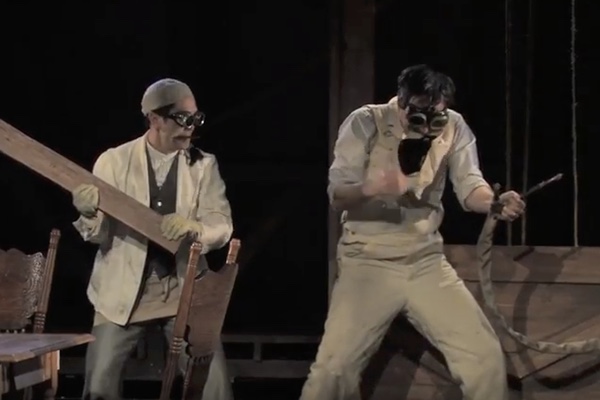A Play About the 1893 Chicago World’s Fair

On paper, Hannah Bos and Paul Thureen’s new play, The Light Years, seems pretty good. It is a story about the dazzling 1893 Chicago World’s Fair, with a little bit of the 1933 Chicago fair tossed in. It tells the tale of two families connected to the fair and how their fortunes did, or did not, turn out. There are plenty of lights, sky rides, a piano solo or two, a plethora of bands and 26 million intrigued Americans who filled up the fair’s midway.
Something went wrong along the midway, though. Bos and Thureen’s drama, which opened last night at Playwrights Horizon, W. 42d Street, in New York, never catches fire. The playwrights bounce back and forth between the two fairs, forty years apart, and the two different families in the story get lost in the shuffle. You cannot tell who is doing what and when they are doing it.
After a rather clever introduction by an eccentric old gentleman, the story starts and works well for awhile. Hilary, an inventor, is toiling on a “mooncart,” a large lighted globe that he hopes he can sell to the 1893 fair official, Steele MacKaye (the proper title of the fair was the “World’s Columbia Exposition,” held to celebrate the 400th anniversary of Columbus's discovery of America). He does not quite know how to finish it and works on it day and night. His wife, thrilled that she has a bike of her own (who knows why) helps a bit and so does their son, a nebulous character who drifts throughout the play.
Then, all of a sudden, we are in 1933 and watch a different family. In this fair, Lou, a songwriter, is trying to sell music to the fair or just about anyone, and has problems in his marriage. The two stories do not connect. Worse, throughout the play you see the bottom quarter or so of an attic above the stage and a strange man wandering about in it. You don’t see the whole attic until the final scene. Why is this man wandering about? Who is he? That is murky.
There is a man who is supposed to connect the stories, Hong Sling. He is the 40 year bridge, but he seems as lost in the play as everybody else.
At one point, something dreadful happens and you believe that event will be the cornerstone of the remainder of the play, but it is not, not at all. The play drones on. The director, Oliver Butler, does a fine job with his actors, and they are skilled. Erik Lochtefeld plays inventor Hillary, Ken Barnett is Lou, Brian Lee Huynh is Hong Sling, Graydon Peter Yosowitz plays son Charlie and Rocco Sisto is Steele MacKaye. Aya Cash plays both Ruth and Adeline, the two wives in the story They all work hard. The problem is in the writing. They play is just disjointed. The comparison between the two fairs, forty years apart, is the theatrical albatross that sinks the production. They would have been better off with either of those two stories.
The tragedy here is that the 1893 fair was a marvelous piece of Chicago and U.S. history, yet none of its highlights are mentioned prominently. Remember that fine murder book, Devil in the White City, the story of serial killer Henry Holmes? Not here. There was the murder of Chicago Mayor Carter Harrison Sr., the giant Ferris wheel, the feud between the fair’s organizer’s and Buffalo Bill, the unveiling of products such as Juicy Fruit gum, Cream of Wheat, Pabst Blue Ribbon beer, the arrival of the Liberty Bell, the first postcards, fluorescent lights and the first dishwasher. The fair was home to some of the most beautifully designed pavilions in the country and sensational rides. Not here. Open just six months, it drew 26 million visitors from all over the world and really established Chicago as a major city just twenty years after the tragic fire that levelled a large part of the town. There is a mammoth amount of historical material to be mined in the two fairs and yet the writers did not probe into much of it. The best thing about the play is the real program from the play in a plastic box in the lobby exhibit.
PRODUCTION: The play is produced by Playwrights Horizon and the Debate Society. Sets: Laura Jellinek, Costumes Michael Krass, Lighting: Russell H. Champs, Sound: Lee Kinney, Original Music: Daniel Kruger. The play is directed by Oliver Butler. It runs through April 2.